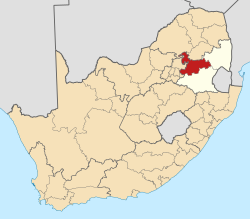Wolwekraal | |
|---|---|
| Coordinates: 25°09′11″S28°57′40″E / 25.153°S 28.961°E | |
| Country | South Africa |
| Province | Mpumalanga |
| District | Nkangala |
| Municipality | Dr JS Moroka |
| Area | |
• Total | 4.88 km2 (1.88 sq mi) |
| Population (2011) [1] | |
• Total | 7,426 |
| • Density | 1,500/km2 (3,900/sq mi) |
| Racial makeup (2011) | |
| • Black African | 99.4% |
| • Indian/Asian | 0.2% |
| • White | 0.3% |
| • Other | 0.1% |
| First languages (2011) | |
| • S. Ndebele | 72.6% |
| • Northern Sotho | 15.7% |
| • Sotho | 3.5% |
| • Zulu | 2.5% |
| • Other | 5.8% |
| Time zone | UTC+2 (SAST) |
Wolwekraal (also known as Maphotla) is a settlement in Dr JS Moroka Local Municipality in the Mpumalanga province of South Africa.


